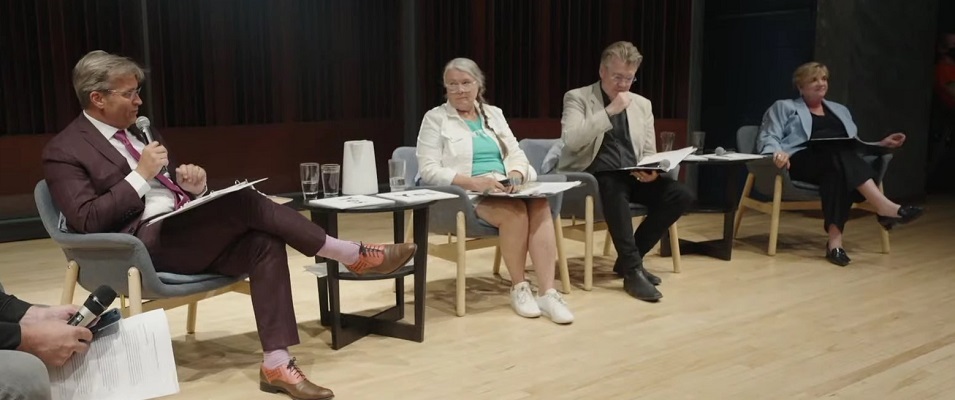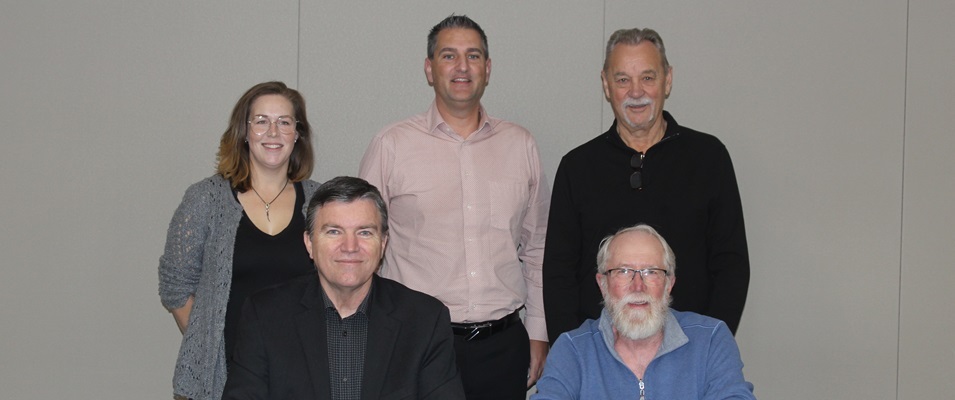
Candidates from each of Manitoba’s four major political parties gathered at the University of Winnipeg on Tuesday, August 29 to discuss their climate and environment commitments leading up to this fall’s provincial election.
The Environment and Climate Change Forum was hosted by 26 separate organizations, each of them concerned about the impending threat of climate change.
On the panel were the PCs’ Kevin Klein, current Minister of the Environment, and the NDP’s Lisa Naylor, environment critic, filling in for Wab Kinew. Joining them were Dougald Lamont, leader of the Manitoba Liberals, and Janine Gibson, leader of the Manitoba Green Party.
The event was moderated by Richard Cloutier of 680 CJOB and Global News.
Cameron Armstrong, regional organizer for Climate Reality Project Canada, opened the forum with an invitation to Gramma Shingoose to provide a blessing on the evening’s proceedings. Shingoose is a Manitoba Indigenous elder and activist.
The next two hours proceeded in question-and-answer format between Cloutier and the candidates.
Cloutier raised questions regarding the development of environmental policy, the plan to meet our obligations under the Paris Agreement, and each party’s intentions in terms of the agricultural sector, which produces 40 percent of the Manitoba’s greenhouse gas (GHG) emissions from farming and food production.
Moving the province away from a fossil-fuel-based economy and towards a green transportation strategy were also topics of conversation.
Green Transportation Strategies
Naylor opened the forum with an overview of her party’s platform, saying that the NDP, if they win on election day, will work hard to meet the federal government’s net zero target for 2050. This will be done in incremental steps by creating a renewable energy grid and developing widespread electric vehicle (EV) charging infrastructure.
As well, the NDP will provide subsidies for new and used EV purchases. Public transit buses will transition from diesel to electric.
Lamont disagreed on this approach.
“Before the pandemic, a huge number of Manitobans were only $200 a month away from insolvency… and it’s only gotten worse,” Lamont said, speaking to current poverty levels.
The Liberal focus, Lamont said, would be to reduce the number of privately owned vehicles by providing better public transit options, not just in Winnipeg but across the province.
Klein was quick to point out that his PC government has already been partnering with rural municipalities on EV transit adoption. He pointed out that the city of Winnipeg has been pushing back against the notion of moving their public transit system to more sustainable options, and that it’s not for lack of pressure from the province.
“You can’t mandate this on another level of government,” Klein said. “You have to partner with them.”
Lamont refuted that argument. “It is literally the job of the Manitoba government to tell the city of Winnipeg what to do,” Lamont said. “It is a creature of the province.”
In turn, Klein was quick to rebuke the NDP’s promise to remove the 14 percent fuel tax created by the PCs. This levy, he said, can be put to good use investing in green infrastructure, such as bike paths and an efficient public transit system.
“One of the biggest problems is that, for 30 years, everyone has been saying, ‘We need to leave this to the private sector to fix. Let the market fix it,’” Lamont argued. “But the market doesn’t want to fix it because it’s run by oil companies.”
Sustainable Agriculture
The parties were equally divided on how best to address the agricultural industry in Manitoba.
As for the Liberals, Lamont said that they would create a carbon rebate for farmers. Similar to carbon offsetting, farmers would be credited for creating carbon sinks such as wetlands or forestation, thus balancing out their GHG creation.
For Gibson, it’s not that simple. Instead, she said, it’s a matter of looking to thousands of years of Indigenous farming practices to glean examples of how land can be farmed without creating the damage caused by western practices over the last 150 years.
“Simplot, the chemical fertiliser plant in Portage, produces the most greenhouse gas emissions of anywhere in Manitoba,” Gibson said. “We need to be helping our farmers get off their addiction to chemicals. All of the supports… for a local organic and resilient agriculture need to be put into place.”
The PC approach, on the other hand, would look at investing in innovative strategies intended to help change the face of Manitoba agriculture. As an example, Klein referenced a company called Enviroclean out of Morden and their process of using heat to turn everyday waste into organic soil within a 24-hour period.
“Government cannot fix this problem alone and none of us up here should be saying we can,” said Klein. “We have to work with the innovators, the young entrepreneurs, the business leaders in our province who are green leaders already.”
Privatizing Manitoba Hydro
The NDP, Liberals, and Green representatives all agreed on one point. Manitoba Hydro, they said, must be maintained as a crown corporation with stricter oversight by the Public Utilities Board.
The goal of Manitoba Hydro, they argued, is first and foremost to provide low-cost energy to Manitobans and should not be privatized.
“We believe that we must start many more Crown-owned corporations, because the private sector is not doing what needs to be done,” Gibson said.
Climate Change Action
All the candidates assumed somewhat different approaches to climate change action.
“An NDP government will use nature-based approaches to help mitigate climate change,” Naylor said. “We’ve committed to protecting 30 percent of Manitoba by 2030 and this includes protecting wetlands which play a vital role in preventing wildfires and flooding.”
Lamont said that his party’s climate policies revolve around the Indigenous model. The problem with the carbon tax in Manitoba, he explained, is that it’s all stick and no carrot.
“We would create a $300 million green fund [every year] to be administered by Efficiency Manitoba and we would change Efficiency Manitoba’s mandate to include climate change,” said Lamont. “The funding would come from the carbon levy as well as through Manitoba Hydro.”
These funds would be available to municipalities in the creation of wetlands or wilderness corridors to help rewild much of Manitoba’s natural landscapes.
As for the PC party, Klein says that he is confident that the current government is on the right track.
“Our PC government’s allegiance to sustainable practices is unshakable and we recognize the importance of the green economy,” Klein said. “We are making Manitoba a leader in Canada in the green economy.”
Encouraging Climate Change Adoption
For the Manitoba Liberals, the answer to creating mass climate change adoption would begin by making it easier for business owners and farmers to incorporate greener initiatives.
They would accomplish this through the creation of the Manitoba Business Development Bank, an independent financial institution that would provide equity to business owners, making them less reliant on government grant monies.
Gibson and her Green Party believe that a major solution to climate change adoption is wrapped up in job creation and providing regular Manitobans with a basic guaranteed income.
“This will help increase the adoption of new technologies and practices,” Gibson noted.
Naylor said that public education and inspiration are the keys to public adoption of climate change. As a result, an NDP government would restore funding to many of the environmental organizations which were cut from PC funding four years prior.
These include the Green Action Centre, Climate Change Connection, and Manitoba Eco-Network.
“Every one of these organizations provides education and motivation to Manitobans,” said Naylor. “[We need groups like this] that help Manitobans adopt environmentally friendly things.”
“I think we underestimate the general population and just how ready they are for change,” Gibson responded. “Respecting our environment is intimately connected with how we respect each other.”



















